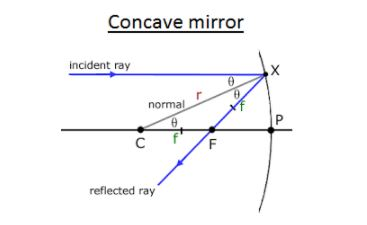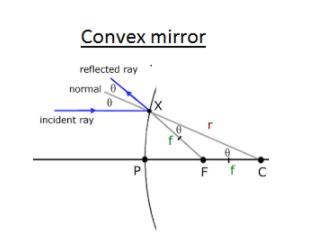
For paraxial rays, show that the focal length of a spherical mirror is one-half of its radius of curvature.
Answer
581.4k+ views
Hint: A curved mirror is a mirror with the curved reflecting surfaces. If the inner side of the spherical mirror is reflecting then it is called a concave mirror and if the outer side of the spherical mirror is reflecting, it is called a convex mirror. To show that the focal length of a spherical mirror is one-half of its radius of curvature we can firstly make the ray diagram for both the mirrors and then apply congruence in triangles to reach the answer.
Complete step-by-step answer:
We will now prove the given formula for both the types of mirrors.
(a) Concave mirror
In the given figure P is the pole, F is the principal focus and C is the centre of curvature of a concave mirror of small aperture. Now, let us assume that a light ray AB be incident on the mirror in a direction parallel to the principal axis of the mirror. It gets reflected along BF. Join CB which is normal to mirror at B.
\[\angle ABC=i\], angle of incidence
\[\angle CBF=r\], angle of reflection
Now, \[\angle ABC=\angle BCF=i\] (alternate angles)
In \[\Delta CBF\] as i=r (law of reflection)
CF = FB
But as FB=FP because aperture is small
CF = FP
That is, F is the centre of PC
Hence, PF = \[\dfrac{1}{2}\]PC
Therefore, we get,
\[f=\dfrac{R}{2}\]

(b) Convex mirror
In the given figure P is the pole, F is the principal focus and C is the centre of curvature of a concave mirror of small aperture. Now, let us assume that a light ray AB be incident on the mirror in a direction parallel to the principal axis of the mirror. It gets reflected along BD and on producing back we see that it appears to come from principal focus F of the mirror. Join CB and produce it to N which is normal to mirror at B.
\[\angle ABN=i\], angle of incidence
\[\angle DBN=r\], angle of reflection
Now, \[\angle FBC=\angle DBN=r\] (opposite angles)
\[\angle BCF=\angle NBA=i\] (corresponding angles)
In \[\Delta CBF\] as i=r (law of reflection)
CF = FB
But as FB=FP because aperture is small
CF = FP
That is, F is the centre of PC
Hence, PF = \[\dfrac{1}{2}\]PC
Therefore, we get,
\[f=\dfrac{R}{2}\]

Note: The paraxial approximation which we have used in this derivation is a small-angle approximation used in Gaussian optics and ray tracing of light through an optical system. A paraxial ray is a ray which makes a small angle to the optical axis of the system and thus always lies close to the axis throughout the system.
Complete step-by-step answer:
We will now prove the given formula for both the types of mirrors.
(a) Concave mirror
In the given figure P is the pole, F is the principal focus and C is the centre of curvature of a concave mirror of small aperture. Now, let us assume that a light ray AB be incident on the mirror in a direction parallel to the principal axis of the mirror. It gets reflected along BF. Join CB which is normal to mirror at B.
\[\angle ABC=i\], angle of incidence
\[\angle CBF=r\], angle of reflection
Now, \[\angle ABC=\angle BCF=i\] (alternate angles)
In \[\Delta CBF\] as i=r (law of reflection)
CF = FB
But as FB=FP because aperture is small
CF = FP
That is, F is the centre of PC
Hence, PF = \[\dfrac{1}{2}\]PC
Therefore, we get,
\[f=\dfrac{R}{2}\]

(b) Convex mirror
In the given figure P is the pole, F is the principal focus and C is the centre of curvature of a concave mirror of small aperture. Now, let us assume that a light ray AB be incident on the mirror in a direction parallel to the principal axis of the mirror. It gets reflected along BD and on producing back we see that it appears to come from principal focus F of the mirror. Join CB and produce it to N which is normal to mirror at B.
\[\angle ABN=i\], angle of incidence
\[\angle DBN=r\], angle of reflection
Now, \[\angle FBC=\angle DBN=r\] (opposite angles)
\[\angle BCF=\angle NBA=i\] (corresponding angles)
In \[\Delta CBF\] as i=r (law of reflection)
CF = FB
But as FB=FP because aperture is small
CF = FP
That is, F is the centre of PC
Hence, PF = \[\dfrac{1}{2}\]PC
Therefore, we get,
\[f=\dfrac{R}{2}\]

Note: The paraxial approximation which we have used in this derivation is a small-angle approximation used in Gaussian optics and ray tracing of light through an optical system. A paraxial ray is a ray which makes a small angle to the optical axis of the system and thus always lies close to the axis throughout the system.
Recently Updated Pages
Master Class 12 English: Engaging Questions & Answers for Success

Master Class 12 Business Studies: Engaging Questions & Answers for Success

Master Class 12 Economics: Engaging Questions & Answers for Success

Master Class 12 Social Science: Engaging Questions & Answers for Success

Master Class 12 Maths: Engaging Questions & Answers for Success

Master Class 12 Chemistry: Engaging Questions & Answers for Success

Trending doubts
What are the major means of transport Explain each class 12 social science CBSE

Which are the Top 10 Largest Countries of the World?

Draw a labelled sketch of the human eye class 12 physics CBSE

Explain sex determination in humans with line diag class 12 biology CBSE

The pH of the pancreatic juice is A 64 B 86 C 120 D class 12 biology CBSE

Explain sex determination in humans with the help of class 12 biology CBSE




